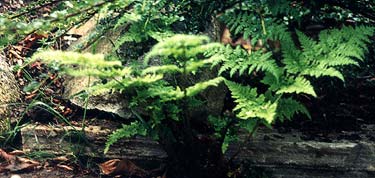 Lacy Crested
Lacy Crested
Broad Buckler Fern
"A garden is a lovesome thing, God wot!
Rose plot, fringed pool, fern'd grot."
-Thomas Edward Brown
1830-1897
1830-1897
When ferns are prepared for the retail market, they come with nice full color tags & condensed enthusiastic text. If they think they can get away with it even a little, the aforementioned enthusiastic text will promise an evergreen capacity for the purchase, but if the buyer doesn't look it up for her specific zone, this promise can lead to disappointment.
My idea of a truly evergreen fern would be the Japanese Tassel Fern which is simply beautiful year round, & marketing methods should not confer this trait quite so willynilly if semi-deciduousness is going to be more the reality. However, the mild dishonesty of the market pitch shouldn't be allowed to reflect unduly on the delicately beautiful Eurasian Dryopteris dilatata "Lepidota Cristata," shown above in a May 2002 photo.
Though only semi-evergreen at best, it is vigorous & beautiful in its seasons, with a weak lingering presence even in winter. We have a very different-looking, upright, tougher-fronded cultivar of the same species called "Jimmy Dyce," & that one is much better at living up to the promise of being an evergreen.
"Lepidota Cristata" is the Lacy Crested Broad Buckler Fern or Crested Wood Fern. D. dilatata varieties as a whole are collectively known as Broad Wood Ferns, or European Shield Ferns. They have considerable range of appearance among the named cultivars, originating as naturally occurring hybrids of D. expansa native to the whole Northern hemisphere, with (it is generally believed) D. azorica.
The Lacy Crested variety has a more uneven growth than the species as a whole, its fronds resembling sprigs of parsley more than the flat triangular leaf of the species. It is sufficiently cold-hardy that it does last into part of the Puget Sound winter, though if any part of it hasn't yet died back on its own by midwinter, it'll be very tattery & inconsequential. Any scruffy bits that remain at the start of spring have to be cut off to make way for new growth; it should not be cut back before March, as the lingering scruffy bits do provide protection for the crown in winter.
It dislikes heat & the further south it is grown, the more delicate it will be, but is ideal for temperate Northwest gardens. In late April it begins its comeback & toward mid-May is looking dandy. When it was still very small, I planted it in a crack between a rock & the walkway at the the head of the stair down to the street, not a choice location but it hasn't seemed to mind. In its extensive range from England to central Russia, it can be found at high & low altitudes in environments ranging from boggy to woodland to rocky, so is very adaptable in the yard, & easily naturalizes along a woodland path.
Its requirements are Fern Basics: loamy organic moist well draining acidic soil in part to full shade. Once established, the species as a whole can stand near drought conditions if it has to, though the Lacy Crested variety is not quite as sturdy in droughty conditions as are varieties with flatter fronds.
Ours has fifteen to eighteen inch fronds its first two years, staying rather flat to to the ground, not raising the fronds more than a foot or so high. But now that it's better established, it produces much longer & wider fronds, so that it has a three foot flattened spread, still only occasionally reaching any taller than a foot & a half high.
If a bigger fern of the species were wanted, it should be the wild form rather than the more ornate Lacy Crested, or a closely related species, D. wallichiana, Wallich's Tall Fern, which has become very large in our garden & is much closer to fully evergreen than is the Lacy Crested. We have several specimens of another fern in the genus, D. erythrosora, the Japanese Autumn Fern, which has colorful & rather chaotic fronds.